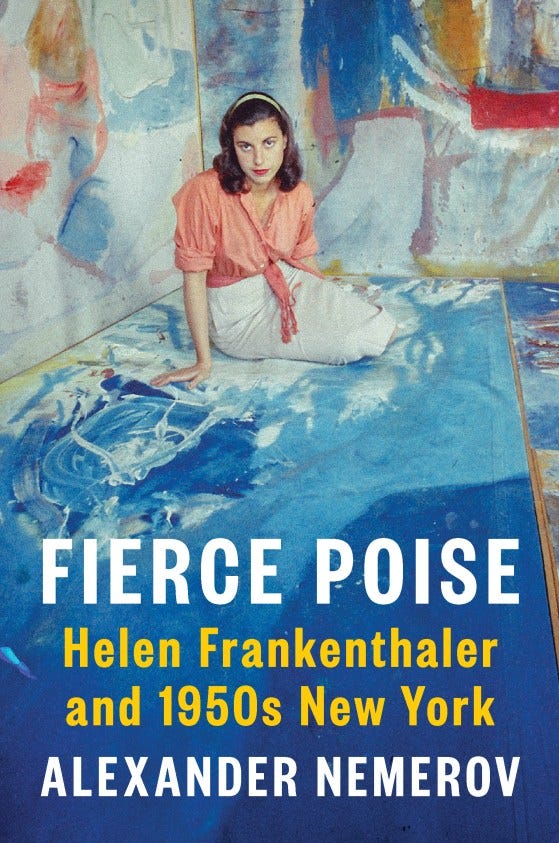If I were to walk into a gallery with a Frankenthaler hanging in its lobby, I’d likely recognize it immediately. Like so many other “greats” of art history, Frankenthaler’s work is distinctly–arguably instantly–recognizable, to many familiar with her period of the 20th century. But despite recognition of her quintessential style of painting, I opened my copy of Fierce Poise unable to identify virtually any details about her life beyond the canvas. Alexander Nemerov changed that.
Fierce Poise is far from a typical biography; Nemerov approaches Frankenthaler’s life through the lens of a transformative decade of her career, the 1950s, telling her story in a series of eleven dates from 1950-1960. Each of these eleven chapters illuminates one of those dates, dripping with vivid detail and together, chronicling the relationships, events, personal triumphs and setbacks that shaped Frankenthaler’s life and work. The unique structure Nemerov employs sets the tone perfectly for the creativity of his writing, from cover to cover.
In the introduction, Nemerov notes that he refers to Frankenthaler as “Helen” throughout the book, despite never having met her. He explains that this choice was “a token of the proximity” he feels to her; a proximity that the reader becomes thoroughly convinced of over the course of the book.1 While his use of her first name is a somewhat unconventional choice when compared to other artist biographies I am familiar with, I never found myself questioning it in Fierce Poise. Frankenthaler is brought to life in the book; Nemerov’s reanimation of her, Helen, allows the reader to feel the same proximity to the artist that Nemerov has. In the process, he sets his book apart from the often austere, analytical style that typifies art criticism and writing.
Historically, Frankenthaler is sometimes overshadowed by many of her contemporaries, the likes of which include Jackson Pollock and Grace Hartigan. Pollock, particularly, is almost equally renowned for his paintings and his fiery, alcohol-fueled temper alike. Comparatively, Frankenthaler seems decidedly more reserved, and too often fades into the background of the New York art scene in the 1950s. In defiance of this, Fierce Poise allows Helen to shine, painting her in vibrant color; Nemerov brings her contemporaries to life around her, but Helen remains unquestioningly the main character of the tales he tells.
One of the primary elements of the book that lingered with me is the remarkable imagery Nemerov crafts: his descriptions mirror the emotive qualities of Frankenthaler’s work and capture the reader’s imagination immediately. The book features color images of many of her works and those of her contemporaries, but the thoughtful consideration and unfussy admiration of Nemerov’s descriptions allow the reader to see her paintings with fresh eyes. The radiance of his imagery is not confined to her paintings: every aspect of Helen’s world and existence is given the same care. From the charming anecdotes of her childhood relationship with her loving father, to the exuberance and quiet determination of young Helen making her debut in the New York party scene– the elegance and glamour of her wedding to Robert Motherwell, to the Modernist decor that forms the backdrop of Helen’s unanticipated struggles in step-parenting– every inch of Frankenthaler’s surroundings are given life, without encroaching on the narrative of the book. The experience of reading Fierce Poise feels more akin to watching an artfully-shot documentary than to reading a typical biography.
Another strength in Nemerov’s writing lies in his perspective. While his respect for Helen is clear, he speaks to the complexities of Frankenthaler’s relationships with her family, her peers, and her lovers without undue assumption, and addresses the varying opinions of Helen’s personal faults plainly, without judgement. In effect, he leaves room for the viewer to form their own opinions of Frankenthaler’s personality and vices; the result is a “living image” of sorts, one that fully humanizes Helen. I found myself empathizing with her at times, and frustrated with her decisions in other cases. I was intrigued by Nemerov’s ability to create such a compellingly lifelike image of her–over the course of the book, I didn’t always like or agree with Helen, but I always wanted to continue reading. Nemerov balances the relatability of her personal struggles with the continuously-elusive elements of her personality, making his understanding of her undeniable, while also leaving lingering mysteries for the reader to consider long after finishing the last chapter.
At the end of Chapter 7, set in 1956, Nemerov mentions that Helen was determined to be well-known, and “sharply oversaw the making of her fame.”2 I kept that concluding paragraph in mind for the remainder of the book, returning to that phrase over and over and wondering what Helen might have thought of Nemerov’s writing on her. I imagine that she would have been pleased with its unconventional chronology and its unique structure: as Nemerov tells us, she had no problem defying the norms, and she always sought the element of surprise in her work. It seems that Helen Frankenthaler exuded a delicate balance of confidence in herself and her work that grew with age; she wanted to prove herself, but she didn’t need to put on airs. Helen likely would have enjoyed being the center of Fierce Poise, and allowing her contemporaries to fade in the light of her work and her legacy. Nemerov has captured a snapshot of Helen Frankenthaler’s essence convincingly in eleven chapters, just as the decade he focuses on offers the reader a snapshot into Frankenthaler’s burgeoning career.
Helen Frankenthaler embodies Fierce Poise, and Alexander Nemerov has done her work and her life justice in this incredible new book.
Fierce Poise jacket art, provided by Penguin Press, an imprint of Penguin Random House.
Special thanks to author Alexander Nemerov (left) and Penguin Random House Publishers for giving me the opportunity to review this book, and entrusting Power Clash with the publication of this review.
You can find out more about Alexander Nemerov and his work here.
Image credit: Suszi Lurie McFadden, 2020. Image provided by Penguin Random House.
This essay was originally written and published by Jackie Andrews on March 23, 2021 for Power Clash Art, an experimental publishing platform they co-founded. Power Clash Art in operation from June 2020-2021. Reviewed copy of Fierce Poise provided by Penguin Random House.






